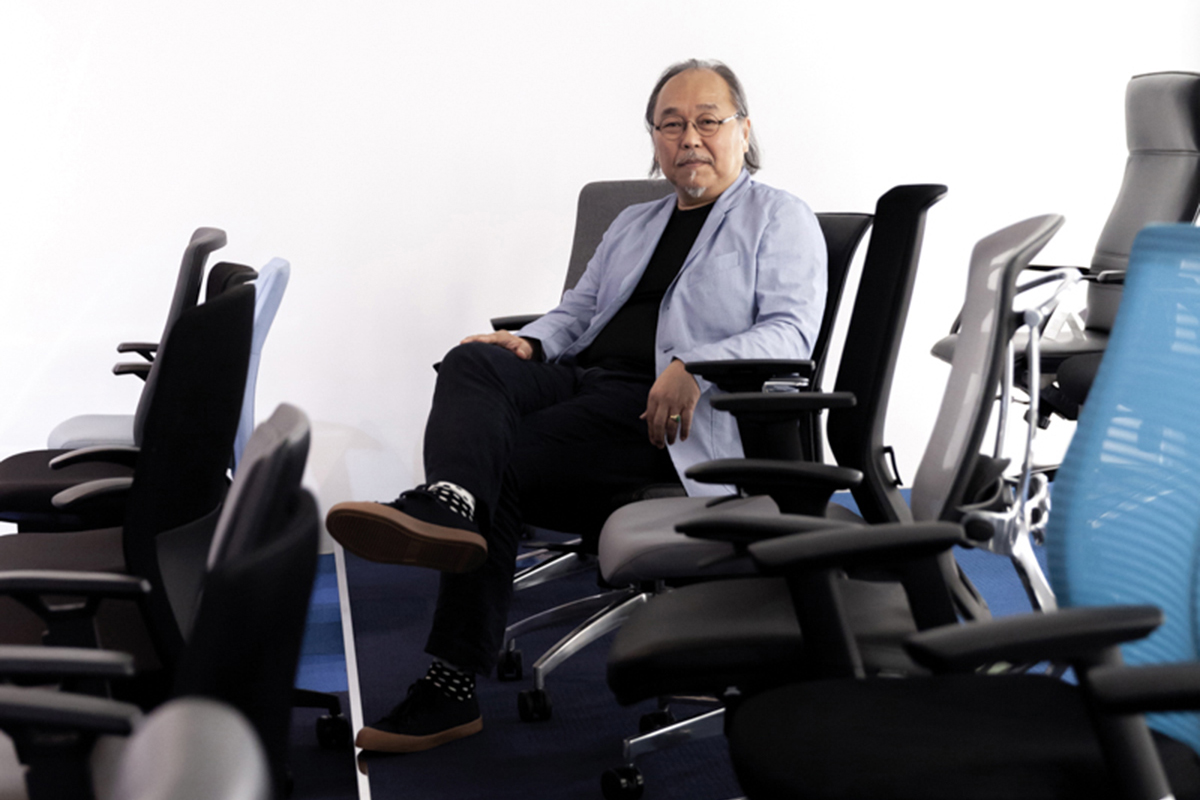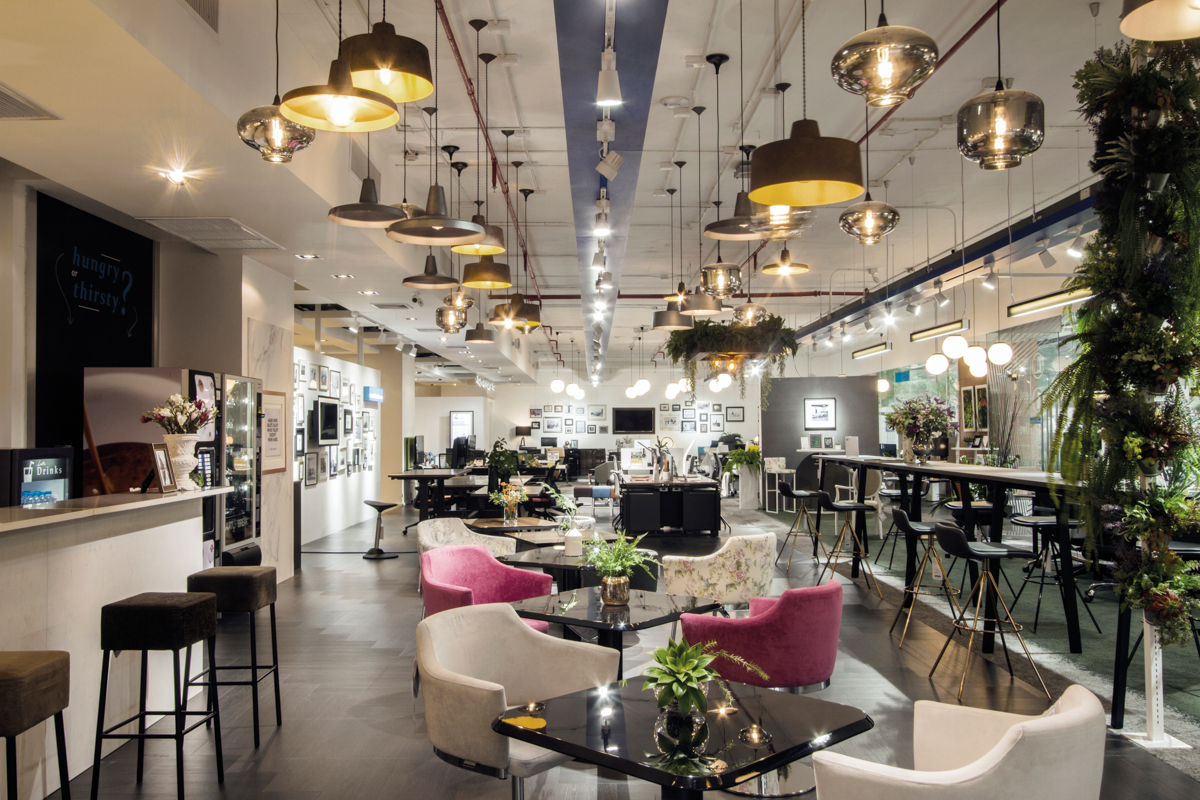art4d speaks with Kittipong Wanapinyosak about the way modernform works in the era of digital transformation

art4d: Could you tell us a bit more about the time when you were appointed as modernform’s design-chief back then?
Kittipong Wanapinyosak: It was the transitioning period when modernfrom was going through its own modernization. I transformed the products from real wood furniture into glossy textures and colors, which make modernform’s furniture even more timeless. They’re minimal but classic. Some of the pieces that are still selling today were designed ten years ago. If you had been following modernform at the time, you would know that modernform had a very strong brand identity when it comes to furniture design. But my role at the company wasn’t exactly seamless as I had to move again to New York because my wife was relocated. It was a great thing because the experience really brought my eyes to the outside world.
Throughout the three years in New York, I was still under a contract with modernform. It was the time when the Internet was getting reliable enough. I returned in 2011 and the interesting thing that was happening was the emergence of the corporate office market. Before I returned home, I went to see Steelcase and started to notice the shift in the design trends. I had been working in this industry for so long and I knew then that I had to bring this approach to modernform. The first collection we did was developed from the ‘workplace personality’ concept and it wasn’t about designing forms of furniture, but designing furniture that accommodated flexibility, modularity and personality and they had to be told through a story. That was the trend back then. But later, I tended to think about ‘people’ more. I’ve realized that everything in this world comes from humans and they’re the kind of creature that is always looking for changes. If we could choose, we wouldn’t want to be like anybody else. That is why the world is turning because humans are driven by the desire to change.
It’s the same thing with furniture. That is why the meaning has changed because if we are talking about what everybody wants, it’s about satisfaction. Everything is judged based on satisfaction. We are satisfied that something is beautiful and resonates with our taste and we are satisfied if something
functions the way we expect it to. That is why I am trying to say that it isn’t just about the aesthetic value of design anymore.
art4d: ช่วยเล่าให้ฟังถึงบทบาทการเป็น design-chief ในอดีต
Kittipong Wanapinyosak: ตอนนั้นเป็นช่วงรอยต่อที่ modernform กำลังจะเปลี่ยนผ่านจากความเป็นสมัยใหม่ ผมเปลี่ยน modernform จากการทำเฟอร์นิเจอร์งานไม้จริง มาเป็นการใช้สีเงาที่ทำให้ฟอร์มของโปรดักท์ modernform มัน timeless กว่าเดิม เรียกได้ว่าเรียบๆ แต่อยู่นาน บางตัวยังขายอยู่ตอนนี้ทั้งที่มันก็ 10 ปีมาแล้ว ถ้าคุณตาม modernform ตอนนั้นจะรู้ว่าในแง่เฟอร์นิเจอร์ modernform มีแบรนดิ้งที่แข็งแรงมากในตอนนั้น แต่การกลับมาครั้งนี้ก็ไม่ใช่ครั้งที่ผมทำงานต่อเนื่องสักเท่าไหร่ เพราะผมต้องย้ายตามภรรยาอีกรอบ คราวนี้ไปอยู่นิวยอร์ก ซึ่งกลับกลายเป็นข้อดีเสียอีก เพราะมันทำให้ผมซึมซับรสนิยมโลกภายนอกไปโดยปริยาย
3 ปีที่อยู่นิวยอร์กผมก็ยังมีสัญญากับที่นี่อยู่ คือมันเป็นช่วงที่การสื่อสารทางอินเตอร์เน็ตเริ่มโอเค ผมกลับมาอีกทีตอนปี 2011 สิ่งที่น่าสนใจมากกว่าเดิมคือตลาดออฟฟิศ ดังนั้น ก่อนที่ผมจะกลับผมก็ไปดู Steelcase คือเราเริ่มเห็นแล้วว่าเทรนด์มันเปลี่ยน เราเป็นคนในวงการนี้ แล้วก็รู้ว่าต้องนำา approach แบบนี้กลับมาใช้ที่ modernform คอลเล็คชั่นแรกที่ทำออกมาเกี่ยวกับ workplace personality คือมันไม่ได้เป็นเรื่องของการออกแบบฟอร์มของเฟอร์นิเจอร์อย่างเดียวแล้ว แต่มันกลายเป็นเรื่องการออกแบบเฟอร์นิเจอร์ที่ต้องรองรับ flexibility, modularity, personality และเล่ามันผ่าน story ยุคนั้นมีเท่านี้ พอถึงยุคต่อๆ มาก ผมก็เปลี่ยนมาคิดถึง “คน” มากขึ้น คือเราต้องเข้าใจว่าทุกสิ่งในโลก
มันเกิดขึ้นจากคน เราต้องเข้าใจว่ามนุษย์เป็นสัตว์ที่ต้องการความเปลี่ยนแปลง ถ้าเลือกได้มนุษย์จะไม่อยากเหมือนคนอื่น โลกมันถึงหมุนไปเพราะมนุษย์มีแรงขับเคลื่อนได้เพรา ความต้องการความเปลี่ยนแปลง
เช่นเดียวกันกับเฟอร์นิเจอร์ ความหมายมันเลยเปลี่ยนไปจากเดิม เพราะถ้าพูดถึงคน สิ่งที่ทุกคนต้องการนั่นคือเรื่องของความพอใจ ทุกอย่างเราตัดสินกันด้วยความพอใจ พอใจที่มันสวย ตรงจริตของเรา พอใจที่ราคาดี พอใจที่ใช้งานดี ผมถึงบอกว่ามันไม่ใช่เรื่องการออกแบบ ไม่ใช่เรื่องการออกแบบเพื่อให้สวยอีกต่อไปแล้ว

art4d: Then what is the goal of your design?
KW: modernform today does not talk about products anymore but we are talking about solutions. What I have been saying all along is about solutions that originate from human beings. So what we need to do now is acknowledge the importance of people or the workers. Then we look into who these workers really are, and we see that this is a time when people from different generations are working together within a physical space that belongs to an organization. The silent group or the people who are in their early 70s are still active members and at the top of the pyramid of the company’s structure. Then we have people like me, the Gen X, then the Gen Y that is currently the major force behind most companies. We also have Gen Z as well, mostly young interns. So what we are expected to do is design this whole space for these different groups of people, which is a workplace. A workspace is smaller in scope and is varied by different working tools used by each individual worker.
A workspace also involves the activities going on within a physical space, which may or may not be relevant to the work. For example, if you were going to hire employees, money wouldn’t be the only thing that would motivate them to work for you. They would ask you whether your company offers training or business trips abroad. The later generations view these activities as something that can help them learn and develop. These things have become the criteria they use when choosing a company they’re going to work for while money is just a short-term goal. People today look at long-term goals because they choose to be in a company or an organization for a short time period before they eventually leave and start their own startups. When I give lectures, the first people who raise their hands and ask me questions are the HR people. They would ask me how to design an office that is appealing to today’s workers. Everything has changed now. It used to be the accounting people who wanted to know how much it would cost to create a certain type of office. But now people are the most crucial resource of a business.
So how can you just settle with selling chairs? Just saying that this chair goes with this desk and how it functions isn’t enough anymore. People do not discuss the what and how anymore, the question we need to answer is why; why do you need this product?
art4d: ถ้าไม่ใช่เพื่อความสวยงาม อะไรคือเป้าหมายของการทำงานออกแบบ
KW: modernform วันนี้ไม่ได้พูดถึงเรื่องโปรดักท์อีกต่อไปแล้ว ตอนนี้เราพูดถึง solution ทั้งหมดที่ผมพูดมันคือ solution ที่มี “คน” เป็นต้นเหตุ แปลว่าตอนนี้สิ่งที่เราต้องทำคือต้องให้ความสำคัญกับคนหรือคำว่า worker นั่นเอง ต้องไปดูว่า worker คือใคร ทุกวันนี้มันเป็นยุคแรกที่คนหลาย generation ทำงานร่วมกันในออฟฟิศเดียว กลุ่ม silent อายุ 70 ต้นๆ ก็ยังมีนะครับ อยู่ข้างบนสุดในหลายบริษัท ลงมายังมี Gen X ซึ่งคือคนยุคผม Gen Y กำลังเป็นพลังสำคัญที่ขับเคลื่อนอยู่ตอนนี้ Gen Z ก็เข้ามาแล้วนะครับ เด็กฝึกงานไง ดังนั้นสิ่งคุณต้องทำคือ ออกแบบก้อนทั้งก้อนให้คนอยู่นั่นคือ workplace ซึ่ง scope ย่อยลงมาคือ workspace ที่ก็จะปรับเปลี่ยนไปตาม work tool ที่ worker แต่ละคนเลือกใช้
workspace ยังเกี่ยวข้องกับกิจกรรมที่เกิดขึ้นในก้อนนั้น ทั้งที่เกี่ยวและไม่เกี่ยวกับงาน เช่น สมมติคุณมีพนักงานใหม่ สิ่งที่จูงใจในการทำงานมันไม่ใช่เรื่องเงินอีกต่อไปแล้ว แต่เป็นคำาถามว่า มีอบรมไหม มีไปเมืองนอกไหม คนรุ่นหลังมองว่าสิ่งนี้คือการเรียนรู้เพื่อที่จะพัฒนา สิ่งนี้กลายเป็น criteria ในการเลือกบริษัทไปแล้ว เรื่องเงินกลายเป็นเป้าหมายระยะสั้นไป คนสมัยนี้เขาพูดถึงเป้าหมายระยะยาว เพราะเขาตั้งใจจะเข้ามาอยู่ตรงนี้แค่ระยะเวลาสั้นๆ เพื่อจะออกไปเป็นสตาร์ทอัพ เวลาผมไปเล็คเชอร์ คนแรกที่ยกมือขึ้นถามผม
คือ HR นะ ว่าเราจะออกแบบออฟฟิศยังไงให้ดึงดูดคนมาทำงาน ทุกอย่างมันเปลี่ยนไปแล้ว ก่อนหน้านี้เวลาผมพูดเรื่องนี้ ฝ่ายการเงินคือคนที่จะลุกขึ้นถามผมว่า “แพงไหม” เพราะอะไรล่ะ เพราะว่าทุกวันนี้คนกลายเป็นทรัพยากรที่สำาคัญที่สุดของธุรกิจ
ทีนี้คุณจะไปขายเก้าอี้อยู่ได้ยังไง แค่บอกให้ได้ว่าเก้าอี้ตัวนี้มันใช้กับอันนี้ สอดคล้องกับไอ้นี่ มันไม่พออีกต่อไปแล้ว ตอนนี้เขาไม่ถกกันเรื่อง What / How อีกแล้ว เรามีหน้าที่ต้องตอบว่า Why ทำไมคุณต้องใช้โปรดักท์ชิ้นนี้หล่ะ
art4d: In the time when the world was looking towards the same thing to the point where it became a trend, how was the evolution of office space in Thailand back then?
KW: In Thailand, what I’ve been saying might apply to very little of it because Thai people are still hung up on hierarchy. Thai people see furniture as a reflection of social status; not a working tool but a symbolic representation of hierarchy. If you’re promoted, your chair is going to have a higher backrest and you’re going to be given a private office. You can’t be with the people who are under you.
art4d: ขอย้อนกลับไปในยุคก่อนที่คนทั้งโลกจะเห็นของสิ่งเดียวกันหมดจนกลายเป็นเทรนด์ ตอนนั้นวิวัฒนาการของออฟฟิศในไทยมันเป็นยังไง
KW: คือถ้าพูดถึงคนไทย สิ่งที่ผมพูดทั้งหมดมันอาจจะใช้ได้นิดหน่อยเอง เพราะสุดท้ายคนไทยยังยึดติดอยู่กับเรื่องฐานันดร คนไทยจะยังมองตลอดเวลาว่าเฟอร์นิเจอร์เป็นเรื่องสถานะทางสังคม คนไทยไม่ได้มองเฟอร์นิเจอร์เป็นแค่อุปกรณ์ใช้งาน แต่มองเป็น symbolic ของฐานันดร ถ้าคุณได้รับการเลื่อนขั้น เก้าอี้คุณต้องมีพนักพิง มันต้องสูงขึ้น คุณต้องมีห้องส่วนตัว อยู่ร่วมกับคนอื่นๆ ไม่ได้
art4d: Does hierarchy make designing office furniture different from home furniture?
KW: Not really. You can see that from dining tables. The leader of the house will have a special spot at the dining table depending on who has more power in the family, the mom or the dad (laugh). In the end, no matter what kind of furniture it is, there’s social status involved.
art4d: แสดงว่าการออกแบบเฟอร์นิเจอร์ในสำนักงานแตกต่างจากเฟอร์นิเจอร์บ้านเพราะมีเรื่องของฐานันดรเข้ามาเกี่ยวข้องหรือเปล่า
KW: ไม่นะ เห็นได้ชัดจากโต๊ะอาหารเลย บนโต๊ะจะมีตำแหน่งประจำของเจ้าของบ้านนั่ง ขึ้นอยู่ว่าครอบครัวนั้น คุณพ่อ / คุณแม่ ใครจะใหญ่กว่ากัน (หัวเราะ) สุดท้ายเฟอร์นิเจอร์ไม่ว่าจะเป็นอะไรก็ตามมันเป็นเรื่องของสถานะทางสังคมทั้งสิ้น

Cool Working Space, where modernform transforms showroom into co-working space which public are allowed to experience the modernform products
art4d: What are modernform’s plans for the future?
KW: What we’re developing is the Cool Working Space. I don’t see it just as a design of a new showroom. I think what we’re doing is designing a new billboard using its location. Once we look at it as a billboard, then it becomes about finding the right content to be on it. These contents will be told through our products. It’s just a little shift in the way we think, and the result is completely different.
We’re applying the model to the space at CDC as well. We’re trying to make a difference and we’re not just making products. We have been collaborating with Exzy, a Thai startup who has been developing this corporate office technology. No matter how elaborate my explanation gets, all I’m saying is that at the end of the day, what really interests us today is human beings because the world is going to have non-human workers soon so it is no longer about work-life balance anymore but more about facilitating the harmony. Why? Work-life balance is about symmetry. Everything has to be equal. This is what you get and this is what I get. But with ‘harmony,’ things are more compromising, everything’s more harmonized. It’s like marriage. If you use balance as the concept of your marriage, you’re doomed. Harmony doesn’t mean everything has to be exactly equal but it’s based on mutual satisfaction. It’s the same thing with work. Our challenge is how to curate the kind of environment that is mutually satisfying for everyone.
art4d: แผนการในอนาคตของ modernform จะเป็นอย่างไรต่อไป
KW: สิ่งที่เรากำลังทำอยู่คือ Cool Working Space ที่ผมไม่ได้มองว่ามันเป็นแค่การออกแบบโชว์รูมใหม่ แต่กลับไปมองว่าผมกำลังออกแบบบิลบอร์ดใหม่ด้วยโลเคชั่นของมัน พอเรามองว่ามันเป็นการออกแบบบิลบอร์ดมันก็เลยกลายเป็นการหาคอนเท็นต์เข้ามาใส่ในบิลบอร์ดแทน คอนเท็นต์พวกนี้จะเล่าผ่านตัวสินค้า ความคิดมันพลิกนิดเดียวแต่ผลลัพธ์มันออกมาคนละเรื่องกันเลย
เรากำลัง apply โมเดลนี้กับสเปซที่ CDC ด้วย คือตอนนี้เรากำลังพยายามแตกต่าง เราไม่ได้ทำแค่โปรดักท์แล้ว จริงๆ ตอนนี้เราร่วมงานกันกับ Exzy สตาร์ทอัพสัญชาติไทยที่มีเทคโนโลยีสำนักงานอยู่ในมือ ผมจะบอกว่าสุดท้าย ถึงผมจะพูดยาวแค่ไหนก็ตาม ทุกวันนี้ที่เราสนใจคือ human being เพราะคุณกำลังจะเริ่มมี worker ที่ไม่ใช่คน มันไม่ใช่เรื่อง work-life balance แล้ว แต่คือการสร้าง harmonize เพราะอะไร เพราะ work-life balance มันคือสมดุล สมดุลคือ symmetric ซึ่งมันเท่ากับว่ามันต้องเท่ากัน คุณได้เท่านี้ ผมต้องได้เท่านี้ แต่คำว่า harmonize มัน compromise กว่า มันกลมกลืนกว่า ยกตัวอย่างชีวิตคู่ ถ้าคุณใช้หลักการ balance กับภรรยาคุณ กับแฟนคุณนะ ตายแน่ๆ harmonize มันไม่จำเป็นต้องเท่ากันแต่ใช้ความพอใจเป็นสำคัญ เช่นเดียวกับการทำงาน ความท้าทายของเราคือเราจะทำยังไงให้เกิดสภาพแวดล้อมที่ลงตัวกับแต่ละบุคคลได้

Cool Working Space, where modernform transforms showroom into co-working space which public are allowed to experience the modernform products
art4d: Last question, with the rise of co-working spaces, does modernform think office spaces will still be important in the future?
KW: I don’t believe that the world will no longer have office spaces. If we reached that day when there wasn’t a single office left, there would be an office emerging. Because we’re talking about human beings, and eventually everything that changes will return to where it used to be. If you’re asking me, anybody can jump on the co-working space bandwagon all they want but I’m going to keep creating this type of office. And if you’re talking about Thailand, I would say that 100%, 10 years from now, offices will still be here because hierarchy can never be eliminated no matter how open-minded you think you are, you’re going to want a private office and a nice chair with a comfortable backrest. You can’t give Aeron chairs to all of your employees. It’s impossible. It’s like the media is going now. Co-working spaces are just like online media. They all look the same because they are running towards the same thing. If we choose to be niche in the way that we’re not pretentiously trying to be niche, we’re going to survive. We’re not abandoning the world and we don’t deny the changes that are happening in the world, but we are just trying not to be swept away by all these trends. That’s all.
art4d: คำถามสุดท้าย ในตอนนี้ที่เทรนด์การทำงานนอกออฟฟิศอย่าง co-working space กำลังมาแรง ทาง modernform คิดว่าออฟฟิศยังเป็นสิ่งจำเป็นอยู่หรือเปล่าในอนาคต
KW: ผมไม่เชื่อว่าโลกนี้จะไม่มีออฟฟิศ ถ้าเราไปไกลกันจนถึงวันที่ทั้งโลกไม่มีออฟฟิศแล้ว มันจะมีออฟฟิศเกิดขึ้นมาแน่ๆ เพราะว่านี่เป็นเรื่องของคน ที่สุดท้ายทุกอย่างที่เปลี่ยนไปมันจะวนกลับมาที่เดิม ยิ่งเป็นผมนะ ตอนนี้ใครจะทำ co-working space ก็ทำไป แต่ผมจะทำออฟฟิศอยู่อย่างนี้ด้วย โดยเฉพาะกับเมืองไทยนะ ร้อยเปอร์เซ็นต์เลย ให้อีก 10 ปี ออฟฟิศมันยังต้องมีอยู่ เพราะเราไม่มีวันลบเรื่องฐานันดรออกไปได้ ถึงคุณจะเป็นคน open mind ขนาดไหน คุณก็ยังอยากได้ห้องส่วนตัว อยากได้เก้าอี้มีพนักพิง จะให้ทุกคนนั่ง Aeron เหมือนกันหมด มันเป็นไปไม่ได้ ก็เหมือนกับสื่อตอนนี้ co-working space ก็คือสื่อออนไลน์ที่มันเหมือนกันไปหมดแล้ว เพราะพวกเขาวิ่งไปหาสิ่งเดียวกัน ถ้าเราเลือกจะเป็น niche แบบที่ไม่ได้ดัดจริตเป็นนะ เราจะอยู่รอดได้ แต่เราไม่ได้ทิ้งโลก เราไม่ได้ปฏิเสธเรื่องการเปลี่ยนแปลงของโลก เพียงแต่ว่าอย่าไปไหลตามกระแส เท่านั้นเอง
Read the full article on art4d No.264 | Click Here
INTERVIEWED BY NAPAT CHARITBUTRA
PORTRAIT: KETSIREE WONGWAN
PHOTO COURTESY OF MODERNFORM EXCEPT AS NOTED
modernform.co.th
